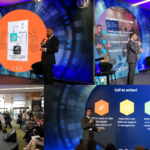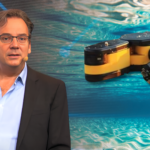ITU News caught up with Chaesub Lee, Director of the ITU Telecommunication Standardization Bureau, to learn more about the latest ITU standards projects addressing AI and Machine Learning and the value of the AI for Good Global Summit.
Where do we stand today in terms of AI applications and how might that evolve?
Innovation by and of AI is accelerating, and this is evidenced by the contributions driving ITU work. AI and Machine Learning are gaining a larger share of the ITU standardization work programme in fields such as network orchestration and management, multimedia coding, service quality assessment, operational aspects of service provision and telecom management, cable networks, digital health, environmental efficiency, and autonomous driving.
But AI and Machine Learning are finding very practical applications across industry sectors, applications with considerable potential to act as a force for good. The scope of debate around AI extends far beyond the scope of any single organization. This is why ITU has called for inclusive global dialogue on the implications of AI for the future of our society, dialogue anchored by the AI for Good Global Summit.
What value do ITU and the broader ‘AI for Good’ community draw from the AI for Good Global Summit?
Alongside recent breakthroughs, new partnerships are also supporting growing confidence in AI. The AI for Good Global Summit continues to offer valuable support to the ‘AI for Good community’ in creating and sustaining these partnerships.
Experts from different fields of expertise are coming together to align incentives for innovation and solve problems with AI. We see connections forming among AI specialists, AI users, data owners and experts in domains to benefit from AI applications – domains where AI could make key contributions to sustainable development.
The United Nations Sustainable Development Goals (SDGs) provide the guiding light to this innovation.
Inclusive dialogue helps all stakeholders to build an understanding of their respective roles in nurturing ICT innovation. This dialogue supports the development of new partnerships and clarifies the contributions expected of various stakeholders, including the contribution expected of ITU standardization. For example, the motivations behind initiatives such as the ITU Focus Groups on ‘AI for Health’ and ‘AI for autonomous and assisted driving’ and the new Global Initiative on ‘AI and Data Commons’ were first elaborated at the AI for Good Global Summit.
Could you share more insight into the aims of these initiatives?
ITU-T Study Groups are the venues where ITU members work together to develop international standards.
ITU-T Focus Groups are flexible structures operational for a short period of time (typically 1-2 years). They accelerate studies in fields of growing strategic relevance to ITU membership. Open to all interested parties, these groups prepare a basis for related standardization work in ITU-T Study Groups.
Let me highlight five open platforms advancing various aspects of AI and Machine Learning.
The ITU Focus Group on ‘Machine Learning for Future Networks including 5G’ is defining the requirements of machine learning as they relate to interfaces, protocols, algorithms, data formats and network architectures.
The ITU Focus Group on ‘Environmental Efficiency for AI and other Emerging Technologies’ will benchmark best practices and describe pathways towards a standardized framework to assess environmental aspects of the adoption of emerging technologies.
The ITU Focus Group on ‘AI for Health’, driven in close collaboration by ITU and WHO, is working towards the establishment of a framework and associated processes for the performance benchmarking of ‘AI for Health’ solutions.
The ITU Focus Group on ‘AI for Autonomous and Assisted Driving’ is working towards the establishment of international standards to monitor and assess the behavioural performance of the AI ‘drivers’ in control of automated vehicles.
The new Global Initiative on ‘AI and Data Common’, established in January 2020, aims to support AI for Good projects in achieving global scale. The Initiative will offer assemblies of resources to launch new AI projects aligned with the SDGs, and scale them up fast.
How are ITU standards addressing AI and Machine Learning?
ICT companies in the networking business are introducing AI and Machine Learning as part of their innovations to optimize network operations and increasing energy and cost efficiency. New ITU standards provide an architectural framework for the integration of machine learning into 5G and future networks (ITU Y.3172), a framework to evaluate intelligence levels across different parts of the network (ITU Y.3173), and a framework for data handling in support of machine learning (ITU Y.3174). These ‘Machine Learning for 5G’ standards are also guiding contributions to a new ITU Global Challenge on AI and Machine Learning in 5G.
AI and Machine Learning play in important part in multimedia coding, an area of ITU standards work known for the Primetime Emmy winning video-compression standards, ITU H.264 MPEG-4 Advanced Video Coding (AVC) and High Efficiency Video Coding (HEVC, published as ITU H.265 | ISO/IEC 23008-2), as well the upcoming Versatile Video Coding (VVC) to be complete before the close of 2020. ITU has also established a new working group (‘Question’) on “Artificial intelligence-enabled multimedia applications” (Q5/16).
AI and Machine Learning are widely used in developing models to assess the quality of speech, audio and video, for example in ITU standards for the quality assessment of audiovisual streaming, in particular ITU P.1203 (progressive-download and adaptive-bitrate AV) and ITU P.1204 (video streaming services up to 4K). New ITU standards address intelligent network analytics and diagnostics (ITU E.475) and the creation and performance testing of Machine Learning-based models to assess the impact of the transmission network on speech quality for 4G voice services (ITU P.565). The lessons learnt developing these ITU standards will be presented by an upcoming ITU Technical Report and Supplement.
Other notable new ITU standards relevant to AI and Machine Learning address environmental sustainability, cable networks, and operational aspects of service provision and telecom management.
A new ITU standard specifies a datacentre infrastructure management (DCIM) system based on Big Data and Artificial Intelligence technology’ (ITU L.1305), supporting DCIM systems in reducing the energy required to control datacentre temperature.
For a range of expert insights on AI for Good, read the latest ITU News Magazine!
New ITU standard provides the framework for a premium cable network platform to support industry in offering advanced multimedia services (ITU J.1600). It is the first of a new series of ITU standards on AI-assisted cable networks.
AI is one of the five characteristics of a new ITU framework to support smart service operation, network management and infrastructure maintenance (ITU M.3041). New ITU standards under development in this domain will address AI-enhanced telecom operation and management, energy saving for 5G Radio Access Networks with AI, and robot-based smart patrols of telecoms networks.
















